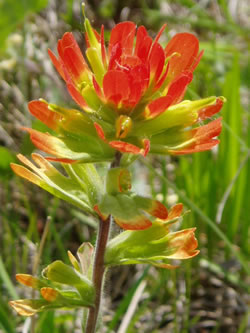Plant of the Week
 Castilleja coccinea range map. USDA PLANTS Database.
Castilleja coccinea range map. USDA PLANTS Database.
 Indian paintbrush. Photo by Christopher David Benda.
Indian paintbrush. Photo by Christopher David Benda.
 Indian paintbrush. Photo by Christopher David Benda.
Indian paintbrush. Photo by Christopher David Benda.
 Indian paintbrush, yellow color. Photo by Christopher David Benda.
Indian paintbrush, yellow color. Photo by Christopher David Benda.
Indian Paintbrush (Castilleja coccinea)
By Christopher David Benda
Indian paintbrush is an attractive member of the parasitic Broomrape family (Orobancaceae). This species was formerly placed in the Figwort family (Scrophullariaceae), which was a hodgepodge of genera that didn’t fit well in other families.
This plant is also called painted cup for the showy cup-like bracts. The genus name “Castilleja” is named after Spanish botanist Domingo Castillejo, and “coccinea” means “red,” referring to the red bracts that surround the flowers.
The showy red structures are technically bracts, a type of modified leaf, and not petals. The actual flower petals are rather inconspicuous, although the tip of the sepals are tinged with red as well. Also, there is a form of this species that has yellow bracts (Castilleja coccinea f. lutescens), as well as a separate closely related species that also has yellow bracts (Castilleja sessiliflora).
These plants are hemiparasites, meaning that although these plants are green and can photosynthesize, they also have the ability to sequester nutrients from other organisms, in this case, from perennial grasses. Despite being obligate parasites for part of their lives, these plants do rely on pollinators for reproduction. A variety of insects visit paintbrush flowers, especially bees. This is somewhat surprising since the color red is difficult for insects to see. However, like most red flowers, this species is especially adapted for pollination by hummingbirds. Hummingbirds have long bills that allow them to reach the nectar rewards at the end of long, tubular flowers. Also, the lack of a lower petal lip denies insects a perch to rest on, favoring hovering organisms like bees and hummingbirds.
This is a biennial species. Although seeds can germinate the same season as when they are released, usually they germinate the following spring and produce a basal rosette that will flower the following season. Seeds are contained in a chambered capsule with two divisions, and once ripe, the capsules split open and wind action helps scatter the up to three hundred seeds within each capsule. Ironically, this plant was used by Native Americans as both a love charm in food and as a poison used to against their enemies, as this species is known to have toxic properties. This species likes sand and grows in both prairies and open woods. It is present in most of the eastern states, including those bordering the Mississippi River, as well as Texas, Oklahoma, and Kansas.


